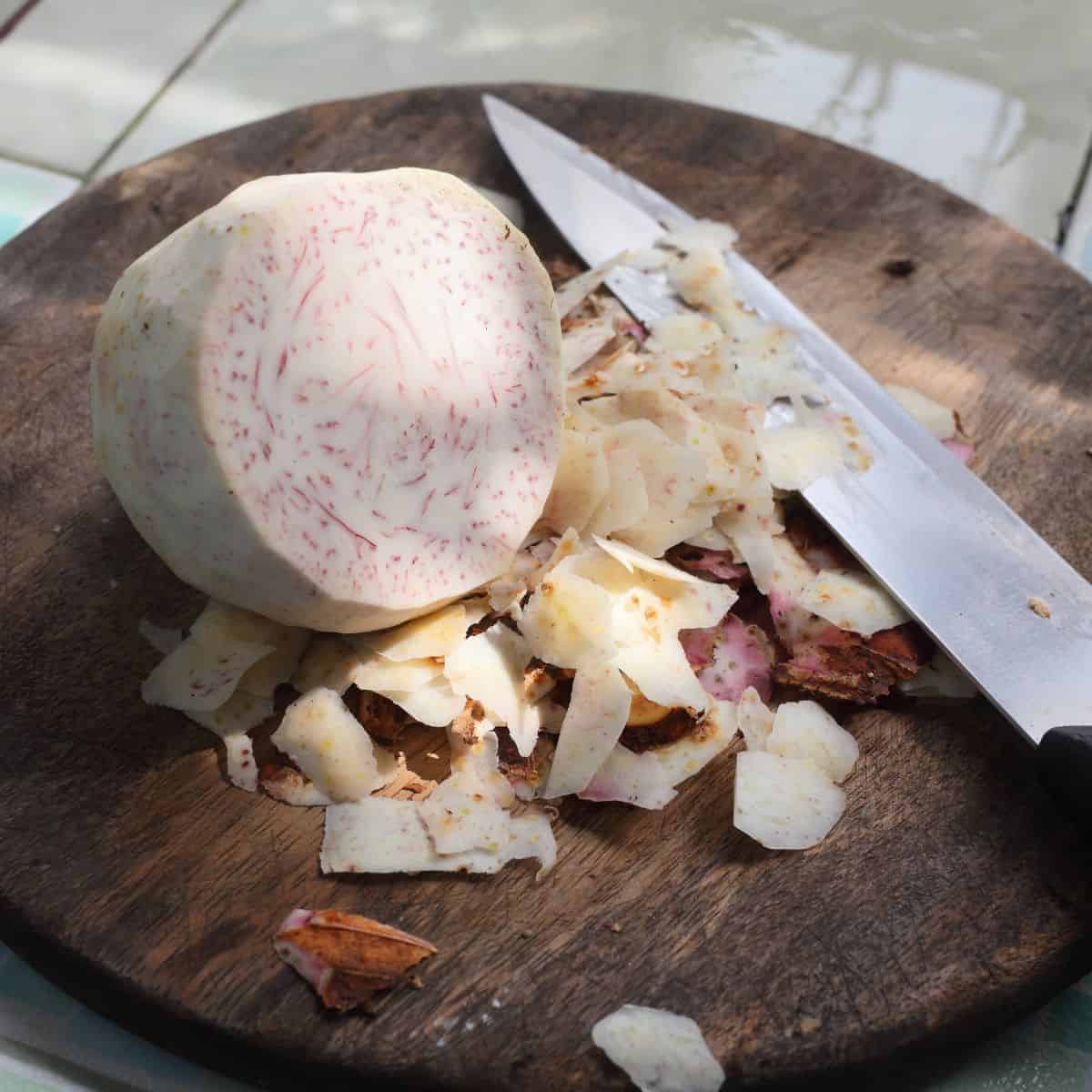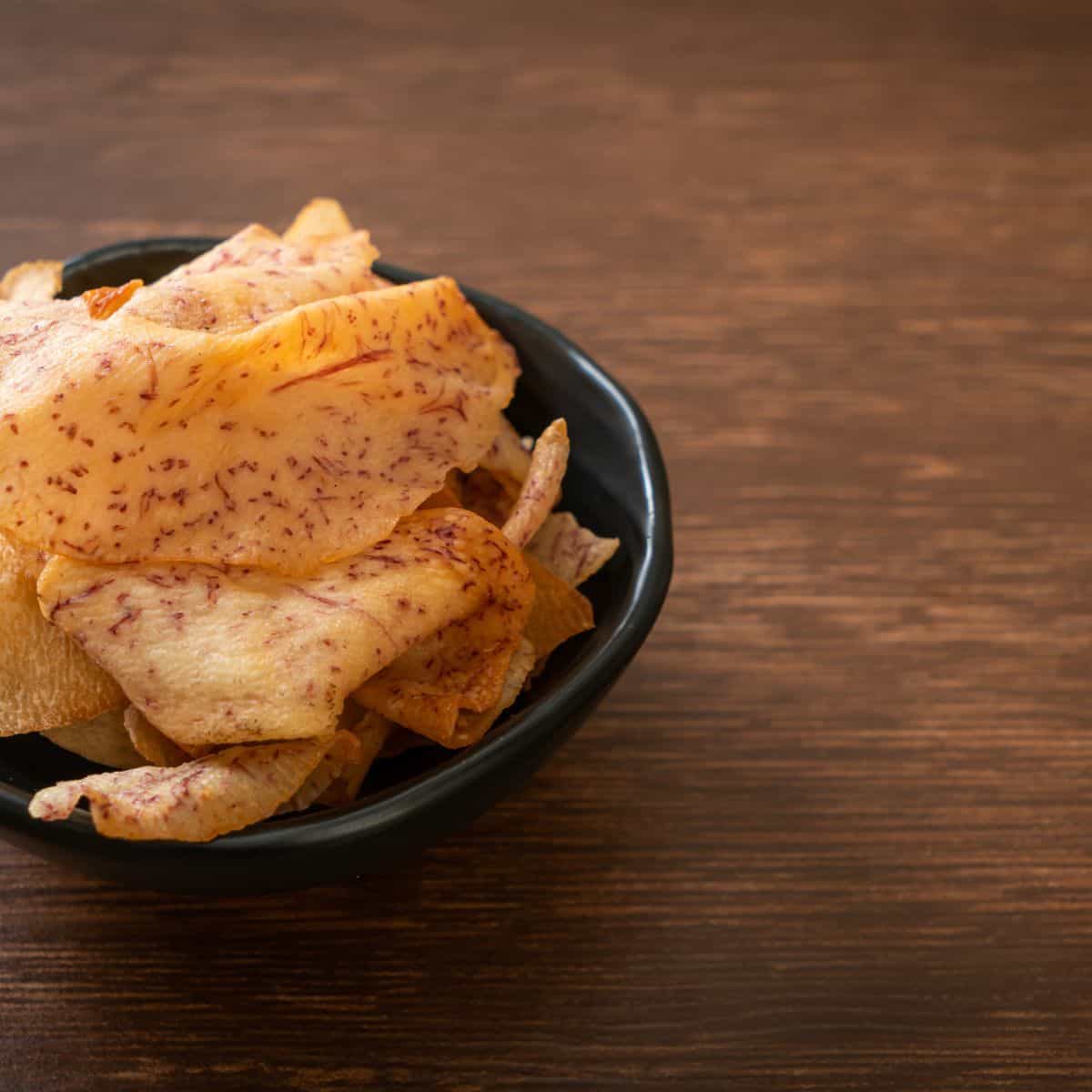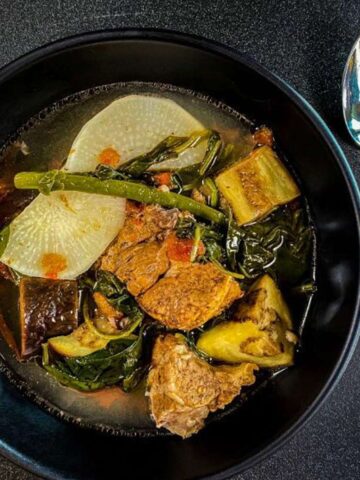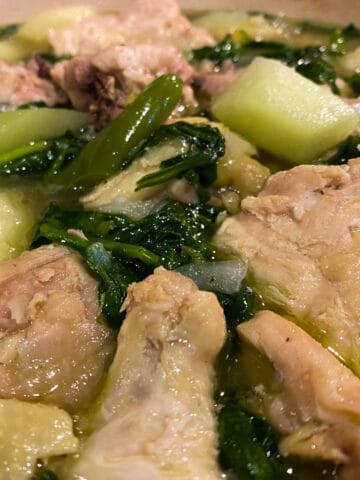In this blog post, we will explore everything about taro root - its nutritional benefits, storage techniques, and various cooking methods.
Jump to:
What Is Taro Root
Taro root, scientifically known as Colocasia esculenta, is a starchy root vegetable that has captivated different cultures for centuries. With its rich history, nutty flavor, and numerous culinary possibilities, taro root has become a staple ingredient in savory and sweet dishes across Southeast Asia, the Pacific Islands, and even West Africa.
The Origins and Nutritional Benefits of Taro Root
Taro root, originating from Southeast Asia, has a rich history deeply intertwined with the culinary traditions of many cultures. With its high levels of vitamin C, fiber, and other essential nutrients, taro root is not only delicious but also a nutritious addition to your diet. Its nutty taste and white flesh make it a unique alternative to common starchy vegetables like sweet potatoes or white potatoes.
Tips for Selecting and Preparing Taro Root
When selecting taro root, look for firm, unblemished tubers without any signs of mold or soft spots. To prepare taro root, peel off the rough outer skin with a knife or vegetable peeler, and then slice or dice it according to your recipe. It is important to note that taro root should never be consumed raw as it contains calcium oxalate crystals that can irritate the mouth and throat. These crystals are destroyed through cooking, so proper preparation is crucial.

Taro Root To Make Sinigang
Taro root gives the Sinigang a slight velvety consistency giving the soup a richer flavor. Follow this recipe for Filipino sour soup (called Sinigang) that uses taro root. So, put on your gloves, and let's dive into the wonders of this versatile tuber.

Cooking Methods
Taro root's versatility shines through various cooking methods. Here are a few popular ways to prepare taro root:
- Boiling: Cut the taro root into small pieces and place them in a pot of boiling water. Cook for about 15-20 minutes or until the taro root becomes tender. Drain the water and use the boiled taro root in soups, stews, or mash it for further preparations.
- Steaming: Place the peeled and sliced taro root in a steamer basket and steam for approximately 20-30 minutes, or until it becomes soft. Steamed taro root can be used as a side dish, added to stir-fries, or mashed for various recipes.
- Frying: Sliced or cubed taro root can be deep-fried until golden and crispy. This method is often used to make taro chips or fritters, offering a delightful snack option.
Once the taro root is cooked, it can be utilized in a wide range of recipes. Mashed taro root can be seasoned with herbs, spices, and butter to create a creamy side dish. Add it to curries, stir-fries, or soups for a unique flavor and texture. Taro root can also be pureed and used as a substitute for other starchy ingredients in baking, such as in cakes or bread.

Storage Techniques for Fresh Taro Root
To maintain the quality and freshness of taro root, proper storage is crucial. Follow these steps to store taro root effectively:
- Short-Term Storage: If you plan to use taro root within a week, store it in a cool, dark place such as a root cellar or a cupboard. Place the taro root in a paper bag to allow air circulation and absorb excess moisture.
- Long-Term Storage: For long-term storage, peel and cut the taro root into desired pieces. Blanch the pieces by briefly immersing them in boiling water, followed by an ice water bath. Pat them dry and place them in airtight containers or freezer bags. Keep them in the freezer for up to six months.
Summary
Taro root, with its fascinating history, diverse culinary uses, and impressive nutritional profile, deserves a place in our culinary repertoire. Whether you're seeking new flavors, exploring international cuisines, or simply looking for a nutritious addition to your diet, taro root can be a delightful and enriching choice. So, next time you encounter this ancient tuber at your local market or on a restaurant menu, don't hesitate to give it a try and embark on a culinary adventure of your own.
FAQ
Taro root has a very mild nutty texture with the sweetness of a sweet potato.
You can find taro root from most local grocery stores, or Asian and Latin markets.
You should never eat taro root raw. Taro contains a bitter-tasting compound called calcium oxalate which can cause your mouth and throat to itch. Once boiled in water this compound is cooked off making it safe to eat.
Related
Looking for other recipes like this? Try these:
Pairing
These are my favorite dishes that you can add taro root:
How-To Instructions

Instructions
Tips for Selecting and Preparing Taro Root
- Look for firm, unblemished tubers without any signs of mold or soft spots.
- Peel off the rough outer skin with a knife or vegetable peeler, and then slice or dice it according to your recipe.
Cooking Methods
- Boiling: Cut the taro root into small pieces and cook them in boiling water, until tender, for about 15-20 minutes. Drain and use the boiled taro root in soups, stews, or mash it for further preparations.
- Steaming: Steam the taro root in a steamer basket for approximately 20-30 minutes, or until it becomes soft. Steamed taro root can be used as a side dish, added to stir-fries, or mashed for various recipes.
- Frying: Sliced or cubed taro root can be deep-fried until golden and crispy. This method often makes taro chips or fritters, offering a delightful snack option.
Storing Techniques
- Short-Term Storage (within a week): Place the taro root in a paper bag and store it in a cool, dark place such as a root cellar or a cupboard.
- Long-Term Storage: Blanch the peeled taro root pieces by briefly immersing them in boiling water, followed by an ice water bath. Pat them dry and place them in airtight containers or freezer bags. Taro root will keep in the freezer for up to six months.
Notes
- Mashed taro root can be added to soups, curries, and stir-fries for a hearty flavor and creamier texture.
- Taro root can be pureed and used as a substitute for other starchy ingredients in baking.
- You can find taro root at your local grocery store, or Asian or Latin markets.



























Marie
Thank you for creating this content. I recently bought some taro root and had no idea how to use it. Now I know. I'm going to try and make your sinigang dish too.
Jocelyn | JOZmahal
Thank you Marie! Glad the post was a benefit to you and let me know how your Sinigang turns out!